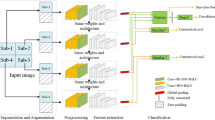Abstract
Image has been widely studied as an effective carrier of information steganography, however, low steganographic capacity is a technical problem that has not been solved in non-embedded steganography methods. In this paper, we proposed a carrier-free steganography method based on Wasserstein GAN. We segmented the target information and input it into the trained Wasserstein GAN, and then generated the visual-real image. The core design is that the output results are converted into images in the trained network according to the map** relationship between preset coding information and random noise. The experimental results indicated that the proposed method can effectively improve the ability of steganography. In addition, the results also testified that the proposed method does not depend on the complex neural network structure. On this basis, we further proved that by changing the length of noise and the map** relationships between coding information and noise, the number of generated images can be reduced, and the steganography ability and efficiency of the algorithm can be improved.
This work was supported in part by the National Natural Science Foundation of China under Grant U2003206 and 62106060; and in part by the Natural Science Base Research Plan in Shaanxi Province of China under Grant 2018JM6103.
Access this chapter
Tax calculation will be finalised at checkout
Purchases are for personal use only
Similar content being viewed by others
References
Tirkel, A.Z., et al.: Electronic watermark. In: Digital Image Computing, Technology and Applications, DICTA 1993, pp. 666–673 (1993)
Yang, C.-H., et al.: Adaptive data hiding in edge areas of images with spatial LSB domain systems. IEEE Trans. Inf. Forensics Secur. 3(3), 488–497 (2008)
Holub, V., Fridrich, J., Denemark, T.: Universal distortion function for steganography in an arbitrary domain. EURASIP J. Inf. Secur. 2014(1), 1–13 (2014). https://doi.org/10.1186/1687-417X-2014-1
Pevný, T., Filler, T., Bas, P.: Using high-dimensional image models to perform highly undetectable steganography. In: Böhme, R., Fong, P.W.L., Safavi-Naini, R. (eds.) IH 2010. LNCS, vol. 6387, pp. 161–177. Springer, Heidelberg (2010). https://doi.org/10.1007/978-3-642-16435-4_13
Holub, V., Fridrich, J.: Designing steganographic distortion using directional filters. In: 2012 IEEE International Workshop on Information Forensics and Security (WIFS). IEEE (2012)
Ruanaidh, J.J.K.O., Dowling, W.J., Boland, F.M.: Phase watermarking of digital images. In: Proceedings of 3rd IEEE International Conference on Image Processing, vol. 3. IEEE (1996)
Cox, I.J., et al.: Secure spread spectrum watermarking for multimedia. IEEE Trans. Image Process. 6(12), 1673–1687 (1997)
Lin, W.-H., et al.: An efficient watermarking method based on significant difference of wavelet coefficient quantization. IEEE Trans. Multimedia 10(5), 746–757 (2008)
Liu, M., et al.: Coverless information hiding based on generative adversarial networks. ar**v preprint ar**v:1712.06951 (2017)
Hu, D., et al.: A novel image steganography method via deep convolutional generative adversarial networks. IEEE Access 6, 38303–38314 (2018)
Zhang, M., et al.: Generative steganography based on boundary equilibrium generative adversarial network. J. Zhengzhou Univ. Nat. Sci. Edn. 52(3), 34–41 (2020)
Arjovsky, M., Chintala, S., Bottou, L.: Wasserstein generative adversarial networks. In: International Conference on Machine Learning. PMLR (2017)
Goodfellow, I.J., et al.: Generative adversarial networks. ar**v preprint ar**v:1406.2661 (2014)
Cui, S., Jiang, Y.: Effective Lipschitz constraint enforcement for Wasserstein GAN training. In: 2017 2nd IEEE International Conference on Computational Intelligence and Applications (ICCIA). IEEE (2017)
Wang, Y., Niu, K., Yang, X.: Image steganography scheme based on GANs. Netinfo Secur. 19(5), 54 (2019)
Fridrich, J., Kodovsky, J.: Rich models for steganalysis of digital images. IEEE Trans. Inf. Forensics Secur. 7(3), 868–882 (2012)
Fridrich, J.: Steganography in Digital Media: Principles, Algorithms, and Applications. Cambridge University Press (2009)
Zhang, Z., et al.: Generative steganography by sampling. IEEE Access 7, 118586–118597 (2019)
Tancik, M., Mildenhall, B., Ng, R.: StegaStamp: invisible hyperlinks in physical photographs. In: Proceedings of the IEEE/CVF Conference on Computer Vision and Pattern Recognition (2020)
Hayes, J., Danezis, G.: Generating steganographic images via adversarial training. ar**v preprint ar**v:1703.00371 (2017)
Li, J., et al.: A generative steganography method based on WGAN-GP. In: Sun, X., Wang, J., Bertino, E. (eds.) ICAIS 2020. CCIS, vol. 1252, pp. 386–397. Springer, Singapore (2020). https://doi.org/10.1007/978-981-15-8083-3_34
Zhou, Z.L., Cao, Y., Sun, X.M.: Coverless information hiding based on bag-of-words model of image. J. Appl. Sci. 34(5), 527–536 (2016)
Zhou, Z., Sun, H., Harit, R., Chen, X., Sun, X.: Coverless image steganography without embedding. In: Huang, Z., Sun, X., Luo, J., Wang, J. (eds.) ICCCS 2015. LNCS, vol. 9483, pp. 123–132. Springer, Cham (2015). https://doi.org/10.1007/978-3-319-27051-7_11
Zheng, S., Wang, L., Ling, B., Hu, D.: Coverless information hiding based on robust image hashing. In: Huang, D.-S., Hussain, A., Han, K., Gromiha, M.M. (eds.) ICIC 2017. LNCS (LNAI), vol. 10363, pp. 536–547. Springer, Cham (2017). https://doi.org/10.1007/978-3-319-63315-2_47
Xu, J., et al.: Hidden message in a deformation-based texture. Vis. Comput. 31(12), 1653–1669 (2014). https://doi.org/10.1007/s00371-014-1045-z
Wu, K.-C., Wang, C.-M.: Steganography using reversible texture synthesis. IEEE Trans. Image Process. 24(1), 130–139 (2014)
Author information
Authors and Affiliations
Corresponding author
Editor information
Editors and Affiliations
Rights and permissions
Copyright information
© 2022 Springer Nature Switzerland AG
About this paper
Cite this paper
Yu, X., Cui, J., Liu, M. (2022). An Embedding Carrier-Free Steganography Method Based on Wasserstein GAN. In: Lai, Y., Wang, T., Jiang, M., Xu, G., Liang, W., Castiglione, A. (eds) Algorithms and Architectures for Parallel Processing. ICA3PP 2021. Lecture Notes in Computer Science(), vol 13156. Springer, Cham. https://doi.org/10.1007/978-3-030-95388-1_35
Download citation
DOI: https://doi.org/10.1007/978-3-030-95388-1_35
Published:
Publisher Name: Springer, Cham
Print ISBN: 978-3-030-95387-4
Online ISBN: 978-3-030-95388-1
eBook Packages: Computer ScienceComputer Science (R0)




